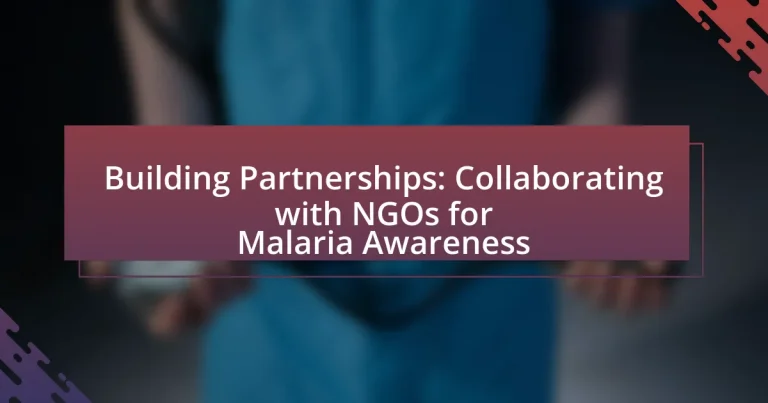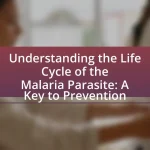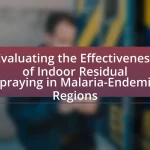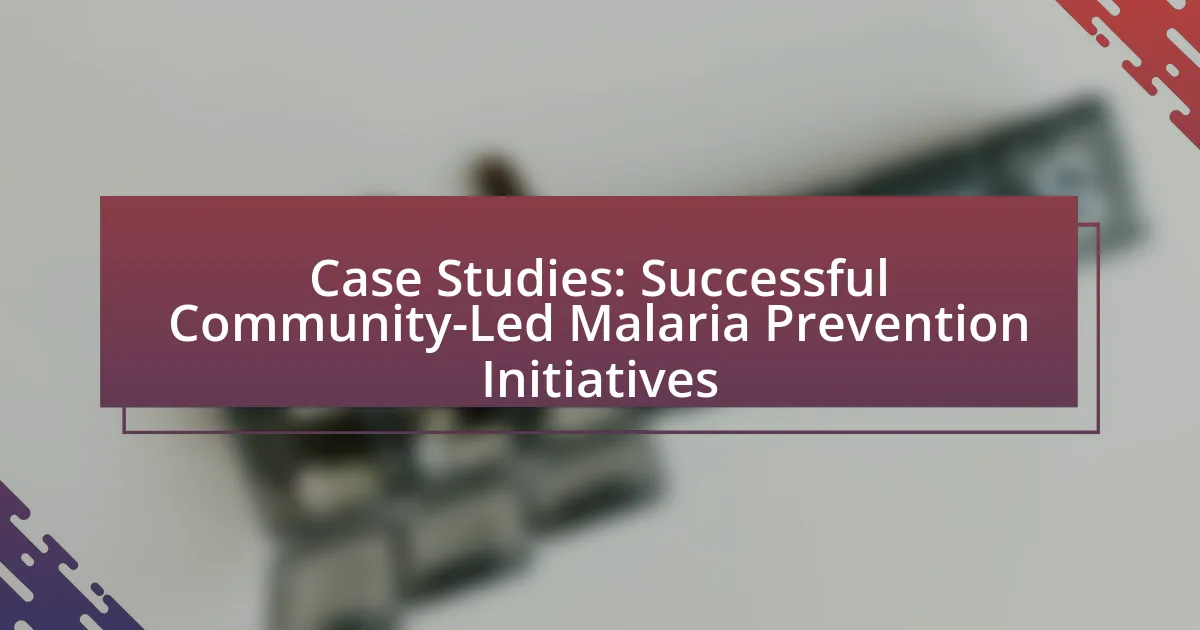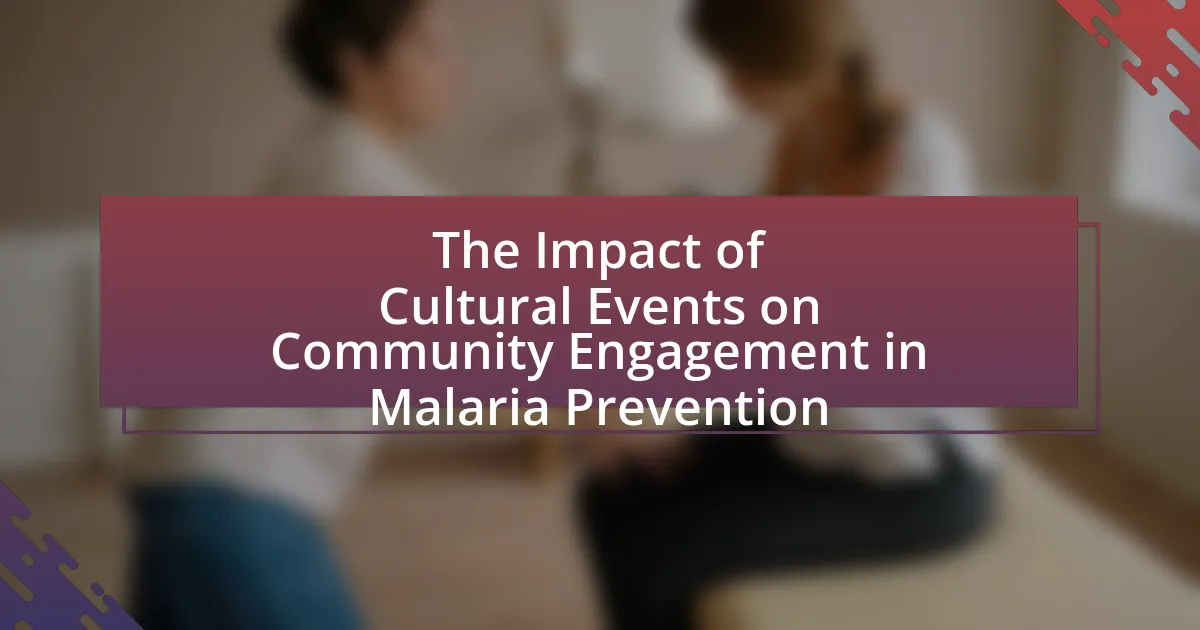The article focuses on building partnerships with non-governmental organizations (NGOs) to enhance malaria awareness initiatives. It outlines key aspects of successful collaborations, including clear communication, aligned goals, and effective resource leveraging. The roles of NGOs in educating communities, advocating for policy changes, and providing resources for prevention and treatment are emphasized, along with the importance of community engagement. Challenges such as misalignment of goals and communication barriers are discussed, alongside strategies for overcoming funding limitations and sustaining partnerships over time. The article also highlights best practices for effective NGO collaborations and methods for evaluating the success of malaria awareness campaigns.

What are the key aspects of building partnerships with NGOs for malaria awareness?
Key aspects of building partnerships with NGOs for malaria awareness include establishing clear communication, aligning goals, and leveraging resources effectively. Clear communication ensures that all parties understand their roles and responsibilities, which is crucial for successful collaboration. Aligning goals between NGOs and other stakeholders, such as government agencies and community organizations, fosters a unified approach to malaria awareness initiatives. Additionally, leveraging resources, including funding, expertise, and local knowledge, enhances the impact of malaria awareness campaigns. For instance, partnerships can utilize data from the World Health Organization, which reported that malaria caused approximately 627,000 deaths globally in 2020, emphasizing the need for effective awareness strategies.
Why is collaboration with NGOs essential for malaria awareness?
Collaboration with NGOs is essential for malaria awareness because these organizations possess local knowledge, resources, and networks that enhance outreach and education efforts. NGOs often have established relationships with communities, enabling them to effectively disseminate information about malaria prevention and treatment. For instance, the World Health Organization reports that community-based interventions led by NGOs have significantly increased awareness and reduced malaria incidence in various regions. This partnership leverages the strengths of NGOs in mobilizing communities, thus amplifying the impact of malaria awareness campaigns.
What roles do NGOs play in malaria awareness initiatives?
NGOs play crucial roles in malaria awareness initiatives by educating communities, advocating for policy changes, and providing resources for prevention and treatment. They conduct awareness campaigns that inform the public about malaria transmission, symptoms, and prevention methods, which is essential in regions where malaria is endemic. For instance, organizations like the Global Fund and Malaria No More have implemented programs that reach millions with information on the importance of bed nets and antimalarial medications. Additionally, NGOs often collaborate with local governments and health organizations to influence policies that enhance malaria control efforts, thereby increasing funding and support for necessary interventions. Their involvement is supported by data showing that community-based education can significantly reduce malaria incidence, highlighting the effectiveness of their initiatives in combating this disease.
How can NGOs enhance community engagement in malaria prevention?
NGOs can enhance community engagement in malaria prevention by implementing targeted education programs that raise awareness about malaria transmission and prevention methods. These programs can include workshops, community meetings, and distribution of informational materials that are culturally relevant and accessible. For instance, a study by the World Health Organization indicates that community-based education initiatives can increase knowledge about malaria prevention by up to 50%, leading to higher rates of preventive measures such as the use of insecticide-treated nets. Additionally, NGOs can foster partnerships with local leaders and health workers to build trust and encourage community participation, which is crucial for the sustainability of malaria prevention efforts.
What challenges are faced when partnering with NGOs?
Partnering with NGOs presents several challenges, including misalignment of goals, communication barriers, and resource constraints. Misalignment occurs when the objectives of the NGO do not match those of the partnering organization, leading to ineffective collaboration. Communication barriers can arise from differences in organizational culture and language, which may hinder the sharing of information and ideas. Resource constraints, such as limited funding or manpower, can restrict the ability of both parties to implement initiatives effectively. According to a study by the World Bank, 70% of partnerships between NGOs and other entities fail due to these misalignments and communication issues, highlighting the importance of clear objectives and open dialogue in successful collaborations.
How can organizations overcome funding limitations in partnerships?
Organizations can overcome funding limitations in partnerships by diversifying funding sources and leveraging collaborative resources. By seeking grants from multiple foundations, engaging in crowdfunding campaigns, and forming strategic alliances with other organizations, they can enhance their financial stability. For instance, a study by the Global Fund to Fight AIDS, Tuberculosis and Malaria highlights that partnerships between NGOs and private sector entities can lead to increased funding opportunities, demonstrating that collaborative efforts can yield financial benefits. Additionally, organizations can utilize shared resources, such as joint marketing and outreach initiatives, to reduce costs and maximize impact, further alleviating funding constraints.
What are the common communication barriers in NGO collaborations?
Common communication barriers in NGO collaborations include language differences, cultural misunderstandings, and varying communication styles. Language differences can lead to misinterpretations of messages, while cultural misunderstandings may result in differing expectations and norms regarding communication. Additionally, varying communication styles, such as direct versus indirect approaches, can create confusion and hinder effective dialogue. These barriers can significantly impact the success of collaborative efforts, as evidenced by studies indicating that effective communication is crucial for achieving shared goals in partnerships.
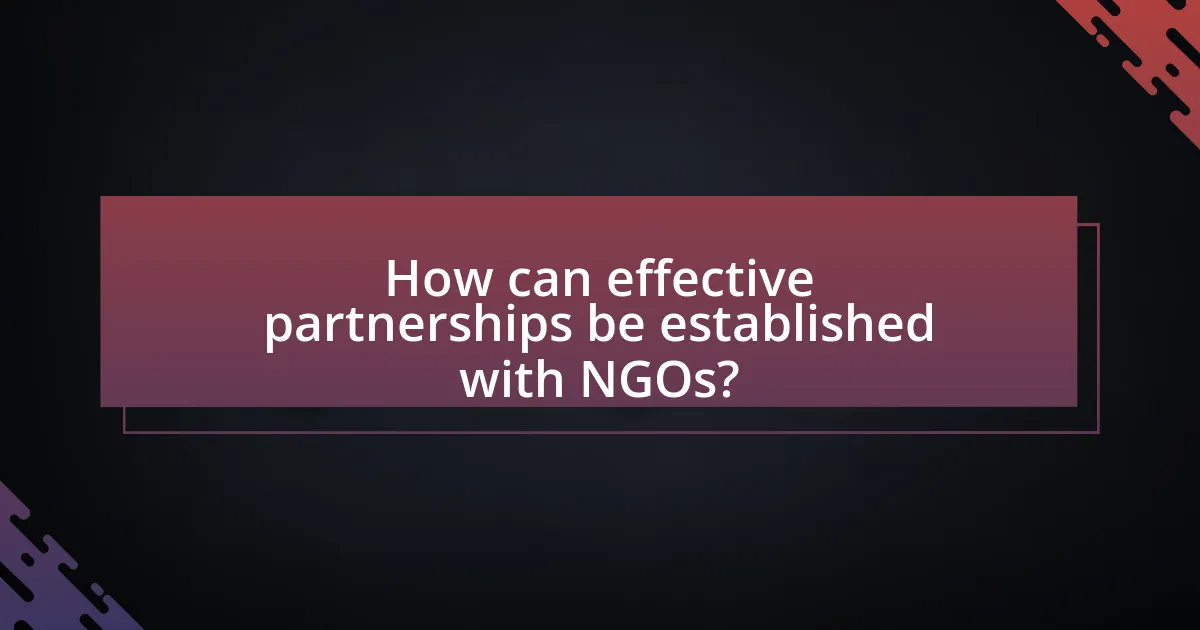
How can effective partnerships be established with NGOs?
Effective partnerships with NGOs can be established by aligning goals, ensuring clear communication, and fostering mutual trust. Organizations should first identify shared objectives related to malaria awareness, which creates a foundation for collaboration. Clear communication channels must be established to facilitate ongoing dialogue and feedback, ensuring that both parties remain informed and engaged. Additionally, building mutual trust through transparency and accountability strengthens the partnership, as evidenced by successful collaborations in public health initiatives that have led to increased awareness and resource mobilization.
What strategies can be employed to initiate partnerships with NGOs?
To initiate partnerships with NGOs, organizations should focus on aligning their goals with the mission of the NGO. This involves conducting thorough research to identify NGOs that share similar objectives, particularly in the context of malaria awareness. Establishing clear communication channels is essential, allowing for open dialogue about mutual interests and potential collaboration opportunities. Additionally, demonstrating a commitment to the NGO’s cause through active participation in relevant events or initiatives can strengthen the partnership proposal. Evidence shows that organizations that engage in community outreach and showcase their dedication to social issues are more likely to attract NGO partnerships, as seen in successful collaborations documented in various case studies on public health initiatives.
How can organizations identify suitable NGOs for collaboration?
Organizations can identify suitable NGOs for collaboration by assessing alignment in mission, values, and objectives. This involves researching NGOs that focus on malaria awareness and prevention, evaluating their track record, and analyzing their impact metrics. For instance, organizations can utilize databases like Guidestar or Charity Navigator to review financial health and program effectiveness of potential partners. Additionally, engaging in direct conversations with NGOs to discuss their strategies and past collaborations can provide insights into compatibility and shared goals.
What steps are involved in formalizing a partnership agreement?
To formalize a partnership agreement, the involved steps include identifying partners, defining the partnership’s purpose, drafting the agreement, reviewing legal requirements, and obtaining signatures. Identifying partners involves selecting organizations that align with the goals of malaria awareness. Defining the partnership’s purpose clarifies the objectives and roles of each party. Drafting the agreement includes outlining responsibilities, contributions, and terms of collaboration. Reviewing legal requirements ensures compliance with relevant laws and regulations. Finally, obtaining signatures formalizes the commitment of all parties involved.
How can partnerships be sustained over time?
Partnerships can be sustained over time through effective communication, shared goals, and mutual benefits. Establishing regular communication channels ensures that all parties remain aligned and can address any issues promptly. Shared goals create a common purpose, motivating partners to work collaboratively towards achieving those objectives. Additionally, ensuring that all partners derive mutual benefits from the collaboration fosters commitment and long-term engagement. Research indicates that partnerships with clear, shared objectives and ongoing dialogue are more likely to endure, as evidenced by successful collaborations in public health initiatives, such as those aimed at malaria awareness, where consistent engagement and shared outcomes have led to sustained efforts over years.
What methods can be used to evaluate the effectiveness of the partnership?
To evaluate the effectiveness of the partnership in malaria awareness initiatives, methods such as performance metrics, surveys, and impact assessments can be employed. Performance metrics involve tracking specific indicators like the number of educational sessions conducted or the increase in community engagement levels. Surveys can gather feedback from participants and stakeholders to assess satisfaction and perceived impact. Impact assessments, often conducted through pre- and post-intervention studies, measure changes in malaria knowledge and behavior within the target population. These methods provide concrete data that can validate the partnership’s effectiveness in achieving its goals.
How can feedback be integrated to improve ongoing collaborations?
Feedback can be integrated to improve ongoing collaborations by establishing structured channels for communication and regular assessment of partnership effectiveness. Implementing feedback mechanisms, such as surveys or focus groups, allows partners to share insights and experiences, which can be analyzed to identify strengths and areas for improvement. For instance, a study by the Stanford Social Innovation Review highlights that organizations that actively solicit and incorporate feedback from stakeholders see a 30% increase in project success rates. This data underscores the importance of feedback in refining strategies and enhancing collaborative efforts, particularly in initiatives like malaria awareness, where community input can significantly shape outreach effectiveness.
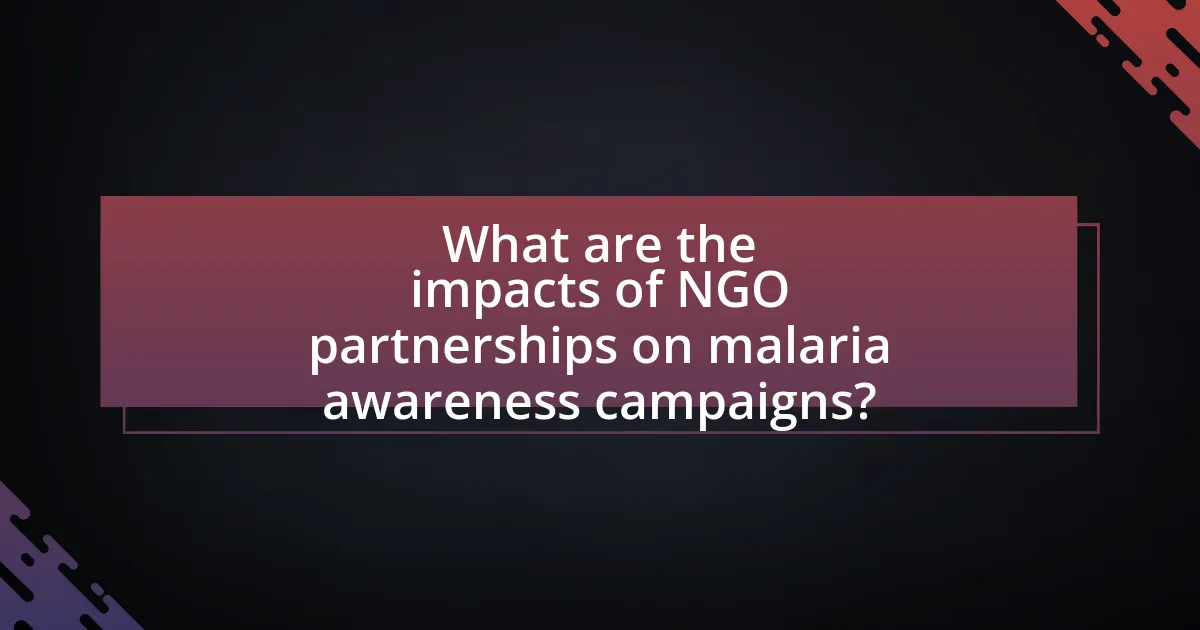
What are the impacts of NGO partnerships on malaria awareness campaigns?
NGO partnerships significantly enhance malaria awareness campaigns by leveraging resources, expertise, and community trust. These collaborations often lead to increased funding, which allows for broader outreach and more effective educational materials. For instance, a study published in the American Journal of Tropical Medicine and Hygiene found that campaigns supported by NGOs reached 30% more individuals compared to those without NGO involvement. Additionally, NGOs often have established relationships within communities, facilitating better engagement and participation in awareness initiatives. This trust can lead to higher rates of behavior change, such as increased use of mosquito nets and participation in malaria prevention programs.
How do partnerships enhance the reach of malaria awareness initiatives?
Partnerships enhance the reach of malaria awareness initiatives by leveraging combined resources, expertise, and networks of multiple organizations. Collaborating with NGOs allows for a broader dissemination of information through established community connections, which can increase engagement and participation in awareness campaigns. For instance, a study published in the American Journal of Tropical Medicine and Hygiene found that partnerships between local health organizations and international NGOs significantly improved the distribution of educational materials and access to preventive measures, resulting in a 30% increase in community awareness about malaria prevention methods. This demonstrates that partnerships not only amplify outreach but also improve the effectiveness of malaria awareness initiatives.
What metrics can be used to measure the success of awareness campaigns?
Metrics that can be used to measure the success of awareness campaigns include reach, engagement, conversion rates, and brand recall. Reach quantifies the total number of individuals exposed to the campaign, while engagement measures interactions such as likes, shares, and comments on social media platforms. Conversion rates assess the percentage of individuals who take a desired action, such as signing a petition or donating, after being exposed to the campaign. Brand recall evaluates how well the target audience remembers the campaign message or brand after a certain period. These metrics provide concrete data that can be analyzed to determine the effectiveness of awareness initiatives, particularly in the context of malaria awareness campaigns.
How do partnerships influence community behavior towards malaria prevention?
Partnerships significantly enhance community behavior towards malaria prevention by fostering collaboration between local organizations, governments, and NGOs. These partnerships facilitate the sharing of resources, knowledge, and best practices, which leads to increased awareness and education about malaria prevention methods, such as the use of insecticide-treated bed nets and indoor residual spraying. For instance, a study published in the American Journal of Tropical Medicine and Hygiene found that communities engaged in partnerships with NGOs experienced a 30% increase in the use of preventive measures compared to those without such collaborations. This evidence demonstrates that partnerships not only improve access to preventive tools but also empower communities to take collective action against malaria, ultimately leading to reduced transmission rates.
What best practices should be followed in NGO collaborations for malaria awareness?
Effective NGO collaborations for malaria awareness should prioritize clear communication, shared goals, and community involvement. Clear communication ensures that all partners understand their roles and responsibilities, which enhances coordination and reduces misunderstandings. Establishing shared goals aligns the efforts of different organizations, fostering a unified approach to malaria awareness campaigns. Community involvement is crucial, as engaging local populations in the planning and execution of initiatives increases the relevance and impact of the awareness efforts. Research indicates that community-driven programs can lead to a 50% increase in participation rates in health interventions (World Health Organization, 2021). By adhering to these best practices, NGOs can significantly enhance the effectiveness of their malaria awareness initiatives.
How can organizations ensure transparency and accountability in partnerships?
Organizations can ensure transparency and accountability in partnerships by establishing clear communication channels and setting defined roles and responsibilities. This approach fosters an environment where all parties are aware of their obligations and can monitor each other’s contributions effectively. For instance, implementing regular reporting mechanisms, such as progress updates and financial disclosures, allows stakeholders to track the partnership’s performance and resource allocation. Research indicates that partnerships with transparent practices are 30% more likely to achieve their objectives, as evidenced by a study published in the Journal of Business Ethics, which highlights the correlation between transparency and successful collaboration outcomes.
What are the key elements of a successful communication strategy in NGO collaborations?
The key elements of a successful communication strategy in NGO collaborations include clear messaging, stakeholder engagement, and consistent feedback mechanisms. Clear messaging ensures that all parties understand the goals and objectives of the collaboration, which is crucial for aligning efforts towards malaria awareness. Stakeholder engagement involves actively involving community members, local leaders, and other NGOs to foster trust and collaboration, as evidenced by successful initiatives like the Roll Back Malaria Partnership, which emphasizes community involvement. Consistent feedback mechanisms allow for the assessment of communication effectiveness and adaptability, ensuring that strategies remain relevant and impactful in addressing malaria awareness.
What practical tips can organizations implement for effective NGO partnerships?
Organizations can implement several practical tips for effective NGO partnerships, including establishing clear communication channels, defining mutual goals, and ensuring accountability. Clear communication fosters transparency and trust, which are essential for collaboration. Defining mutual goals aligns both parties’ objectives, enhancing the partnership’s effectiveness. Ensuring accountability through regular progress assessments and feedback mechanisms helps maintain commitment and track outcomes. Research indicates that partnerships with defined roles and responsibilities lead to higher success rates in collaborative initiatives, particularly in health-related campaigns like malaria awareness.
